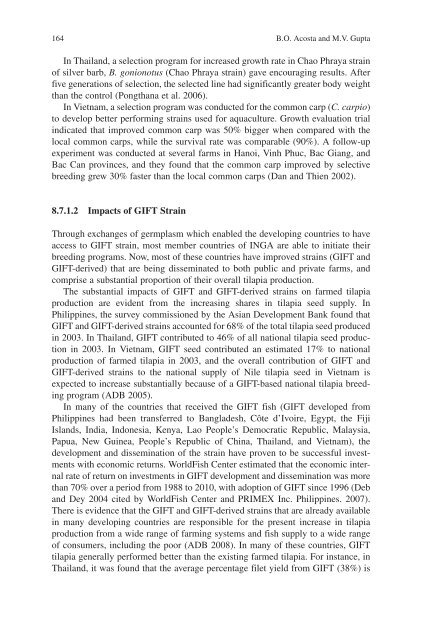Success Stories In Asian Aquaculture - Library - Network of ...
Success Stories In Asian Aquaculture - Library - Network of ...
Success Stories In Asian Aquaculture - Library - Network of ...
- No tags were found...
You also want an ePaper? Increase the reach of your titles
YUMPU automatically turns print PDFs into web optimized ePapers that Google loves.
164 B.O. Acosta and M.V. Gupta<strong>In</strong> Thailand, a selection program for increased growth rate in Chao Phraya strain<strong>of</strong> silver barb, B. gonionotus (Chao Phraya strain) gave encouraging results. Afterfive generations <strong>of</strong> selection, the selected line had significantly greater body weightthan the control (Pongthana et al. 2006) .<strong>In</strong> Vietnam, a selection program was conducted for the common carp ( C. carpio )to develop better performing strains used for aquaculture. Growth evaluation trialindicated that improved common carp was 50% bigger when compared with thelocal common carps, while the survival rate was comparable (90%). A follow-upexperiment was conducted at several farms in Hanoi, Vinh Phuc, Bac Giang, andBac Can provinces, and they found that the common carp improved by selectivebreeding grew 30% faster than the local common carps (Dan and Thien 2002) .8.7.1.2 Impacts <strong>of</strong> GIFT StrainThrough exchanges <strong>of</strong> germplasm which enabled the developing countries to haveaccess to GIFT strain, most member countries <strong>of</strong> INGA are able to initiate theirbreeding programs. Now, most <strong>of</strong> these countries have improved strains (GIFT andGIFT-derived) that are being disseminated to both public and private farms, andcomprise a substantial proportion <strong>of</strong> their overall tilapia production.The substantial impacts <strong>of</strong> GIFT and GIFT-derived strains on farmed tilapiaproduction are evident from the increasing shares in tilapia seed supply. <strong>In</strong>Philippines, the survey commissioned by the <strong>Asian</strong> Development Bank found thatGIFT and GIFT-derived strains accounted for 68% <strong>of</strong> the total tilapia seed producedin 2003. <strong>In</strong> Thailand, GIFT contributed to 46% <strong>of</strong> all national tilapia seed productionin 2003. <strong>In</strong> Vietnam, GIFT seed contributed an estimated 17% to nationalproduction <strong>of</strong> farmed tilapia in 2003, and the overall contribution <strong>of</strong> GIFT andGIFT-derived strains to the national supply <strong>of</strong> Nile tilapia seed in Vietnam isexpected to increase substantially because <strong>of</strong> a GIFT-based national tilapia breedingprogram (ADB 2005) .<strong>In</strong> many <strong>of</strong> the countries that received the GIFT fish (GIFT developed fromPhilippines had been transferred to Bangladesh, Côte d’Ivoire, Egypt, the FijiIslands, <strong>In</strong>dia, <strong>In</strong>donesia, Kenya, Lao People’s Democratic Republic, Malaysia,Papua, New Guinea, People’s Republic <strong>of</strong> China, Thailand, and Vietnam), thedevelopment and dissemination <strong>of</strong> the strain have proven to be successful investmentswith economic returns. WorldFish Center estimated that the economic internalrate <strong>of</strong> return on investments in GIFT development and dissemination was morethan 70% over a period from 1988 to 2010, with adoption <strong>of</strong> GIFT since 1996 (Deband Dey 2004 cited by WorldFish Center and PRIMEX <strong>In</strong>c. Philippines. 2007) .There is evidence that the GIFT and GIFT-derived strains that are already availablein many developing countries are responsible for the present increase in tilapiaproduction from a wide range <strong>of</strong> farming systems and fish supply to a wide range<strong>of</strong> consumers, including the poor (ADB 2008) . <strong>In</strong> many <strong>of</strong> these countries, GIFTtilapia generally performed better than the existing farmed tilapia. For instance, inThailand, it was found that the average percentage filet yield from GIFT (38%) is
















